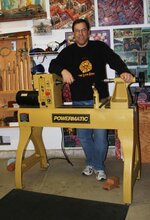Once again, what is the fascination of knowing what the speed is?
At higher RPMs, some materials can fail catastrophically. It's a good idea to know what your materials will handle and what speed you're turning so you can stay within bounds.
More important than just RPM is surface speed: for a given RPM, surface speed will increase with the diameter, affecting both surface finish (for metal) and tool wear, as well as stress on the material being turned.
Simply because your test subjects couldn't accurately determine the speeds they were using without a readout doesn't diminish the importance of knowing.
We are talking a wood lathe, not metal working here. In metal working, you are correct, to a point, depending on the opreation.
As for materials that can catostrophically fail due to straight speed, the thinner we make them, the more likely hood of a catastrophy as well, so your theory says we cannot make things thin either. And knowing what the speed of failure is is not going to stop the failure.
SPEED helps much much more than it hurts.
It reduces the aire time that we encounter over voids and while roughing.
It allows many more cuts per inch which will typically give a better finish.
It actually decreases the amount of material removed PER CUT which has a better effect on the material being turned and the tools on a stress factor.
And still, the only reason for knowing a speed is to replicate it for a given purpose, not for just general turning.
My PERSONAL opinion is that people are getting too hyped up on what speed they NEED TO SEE and what can actually work for them.
As for the test subjects, they all stated they felt just as safe at the higher speed as they did when they typically turned.
And once again, as per my original it is SAFE SPEED. If the machine is waltzing its way across the room, it is unsafe. If it is swaying where it stands, then the finish will not be good.
I think too many people stress they have to have a digital readout without really knowing why, and that the technology phase of turning is really starting to take over in this area.
and as far as knowing what speed the lathe is spinning, he can still get an idea from the dial position without the expense of a digital readout

